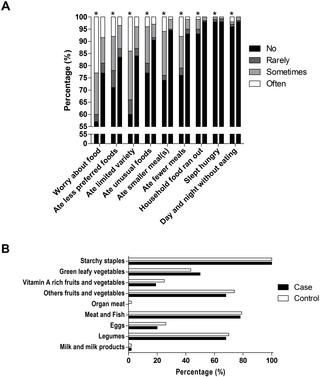PLOS Neglected Tropical Diseases ( IF 3.4 ) Pub Date : 2018-03-13 , DOI: 10.1371/journal.pntd.0006317 Salma Oktaria 1, 2 , Norma Sofisa Hurif 3 , Wardiansyah Naim 4 , Hok Bing Thio 1 , Tamar E C Nijsten 1 , Jan Hendrik Richardus 3

|
Background
Poverty has long been considered a risk factor for leprosy and is related to nutritional deficiencies. In this study, we aim to investigate the association between poverty-related diet and nutrition with leprosy.
Methodology/Principal findings
In rural leprosy-endemic areas in Indonesia, we conducted a household-based case-control study using two controls for each case patient (100 recently diagnosed leprosy patients and 200 controls), matched for age and gender. All participants were interviewed to collect information on their demographics, socioeconomic situation, health, and diet. Body mass index, dietary diversity score, as well as anemia and iron micronutrient profiles were also obtained. By means of univariate, block-wise multivariate, and integrated logistic regression analyses, we calculated odds ratios between the variables and the occurrence of leprosy. Unstable income (odds ratio [OR], 5.67; 95% confidence interval [CI], 2.54–12.64; p = 0.000), anemia (OR, 4.01; 95% CI, 2.10–7.64; p = 0.000), and higher household food insecurity (OR, 1.13; 95% CI, 1.06–1.21; p = 0.000) are significantly associated with an increased risk of having leprosy. Meanwhile, higher education (OR, 0.34; 95% CI, 0.15–0.77; p = 0.009) and land ownership (OR, 0.39; 95% CI, 0.18–0.86; p = 0.019) have significant protective associations against leprosy. Although lower dietary diversity, lack of food stock, food shortage, low serum iron, and high ferritin were found more commonly in those with leprosy, the occurrence of leprosy was not significantly associated with iron deficiency (OR, 1.06; 95% CI, 0.10–11.37; p = 0.963).
Conclusions/Significance
Food poverty is an important risk factor for leprosy susceptibility, yet the mechanisms underlying this association other than nutrient deficiencies still need to be identified. With a stable incidence rate of leprosy despite the implementation of chemoprophylaxis and multidrug therapy, improving dietary diversity through food-based approaches should be initiated and directed toward high-prevalence villages. The possible underlying factors that link poverty to leprosy other than nutrient deficiencies also need to be identified.
中文翻译:

饮食多样性和贫困是印度尼西亚麻风病的危险因素:病例对照研究
背景
长期以来,贫困一直被认为是麻风病的危险因素,并且与营养缺乏有关。在这项研究中,我们旨在调查与贫困相关的饮食和营养与麻风病之间的关联。
方法/主要发现
在印度尼西亚农村麻风病流行区,我们进行了一项以家庭为基础的病例对照研究,对每个病例患者使用两个对照(100 名最近诊断的麻风病患者和 200 名对照),并进行年龄和性别匹配。所有参与者都接受了采访,以收集有关他们的人口统计、社会经济状况、健康和饮食的信息。还获得了体重指数、饮食多样性评分以及贫血和铁微量营养素谱。通过单变量、分块多变量和综合逻辑回归分析,我们计算了变量与麻风病发生之间的比值比。收入不稳定(比值比 [OR],5.67;95% 置信区间 [CI],2.54–12.64;p = 0.000)、贫血(OR,4.01;95% CI,2.10–7.64;p = 0.000)和家庭收入较高粮食不安全(OR,1.13;95% CI,1.06–1.21;p = 0.000)与麻风病风险增加显着相关。同时,高等教育(OR,0.34;95% CI,0.15–0.77;p = 0.009)和土地所有权(OR,0.39;95% CI,0.18–0.86;p = 0.019)对麻风病具有显着的保护性关联。尽管饮食多样性较低、食物库存不足、食物短缺、低血清铁和高铁蛋白在麻风病患者中更为常见,但麻风病的发生与缺铁并无显着相关性(OR,1.06;95% CI,0.10) –11.37;p = 0.963)。
结论/意义
食物匮乏是麻风病易感性的一个重要风险因素,但除营养缺乏之外,这种关联的潜在机制仍需确定。尽管实施了化学预防和多种药物治疗,但麻风病发病率仍保持稳定,因此应开始通过以食物为基础的方法改善饮食多样性,并针对高患病率村庄。除了营养缺乏之外,还需要确定将贫困与麻风病联系起来的潜在潜在因素。











































 京公网安备 11010802027423号
京公网安备 11010802027423号